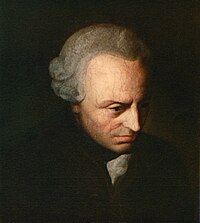|
Metaphysics of Morals
The Metaphysics of Morals (German: Die Metaphysik der Sitten) is a 1797 work of political and moral philosophy by Immanuel Kant. It is also Kant's last major work in moral philosophy. The work is divided into two sections: the Doctrine of Right, dealing with political rights, and the Doctrine of Virtue, dealing with ethical virtues. In this work, Kant develops the political and ethical philosophy for which the Groundwork and Critique of Practical Reason provide the foundation. General Structure of the WorkThe work is divided into two main parts, the Rechtslehre and the Tugendlehre. Mary J. Gregor's translation (1991) explains these German terms as, respectively, the Doctrine of Right, which deals with the rights that people have, and the Doctrine of Virtue, which deals with the virtues they ought to acquire. The Doctrine of Right also deals with required actions concerning the external relationships between people and the Doctrine of Virtue also deals with the internal requirements that characterize moral action and duty. Rechtslehre has also been translated as the Science of Right (Hastie) or the Metaphysical Elements of Justice (Ladd). SummaryThe Doctrine of Right is grounded in republican interpretation of origins of political community as civil society and establishment of positive law. Published separately in 1797, the Doctrine of Right is one of the last examples of classical republicanism in political philosophy.[1] The Doctrine of Right contains the most mature of Kant's statements on the peace project and a system of law to ensure individual and public rights. It expounds fundamental and coercively enforceable principles of external conduct between people, foremost among them being the universal principle of right which states:
It also discusses property rights, punitive justice, as well as state and cosmopolitan rights. The Doctrine of Virtue develops Kant's ethical theory, which he had already laid the foundation in the Groundwork of the Metaphysics of Morals (1785). Kant particularly emphasizes treating humanity as an end in itself. The duties are analytically treated by Kant, who distinguishes duties towards ourselves from duties towards others. The duties are classified as perfect duties and imperfect duties. Kant thinks imperfect duties allow a latitudo, i.e., the possibility of choosing maxims. The perfect duties instead do not allow any latitudo. Kant uses this distinction in discussing some of the duties that were shown as examples in the Groundwork in more detail (viz., not lying, not committing suicide, cultivating one's talents, and being beneficent toward others). Thus, Kant distinguishes "Virtue" and "Right": the "Doctrine of Right" contains rights as perfect duties towards others only. InfluenceIn the English-speaking world, the Metaphysics of Morals (1797) is not as well known as Kant's earlier works, the Groundwork of the Metaphysics of Morals (1785) and the Critique of Practical Reason (1788), but it has experienced a renaissance through the pioneering work of Mary J. Gregor.[4] English translationsTranslations of the entire book:
Translations of Part I:
Translations of Part II:
See alsoReferences
External linksWikisource has original text related to this article:
|
|||||||||||||||||||||||||||||||||||||||||||

